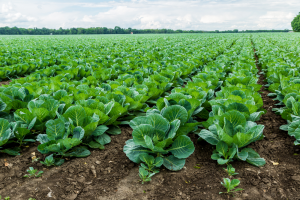By Breanna Kendrick 
Cabbage is inflicted with numerous insect pests and plant diseases, but black rot has been the leading threat to the Georgia cabbage industry for years.
Black rot is caused by the bacterium Xanthomonas campestris pv. campestris. Bhabesh Dutta, vegetable Extension pathologist at the University of Georgia, has been focusing his research on this disease.
One reason for the prevalence of black rot is the range of sources of pathogen inocula. The inoculum for black rot can come from infected cabbage seed or transplants, weeds and plant debris in the soil.
Use of resistant/tolerant varieties is the key for managing this pathogen, but there are no resistant varieties to all the different races of this pathogen.
This disease can be seen every year in the transplant houses. Dutta has also seen this disease in the field. There were limited reports of the disease last year; however, there were several reports prior to 2017 both in greenhouses and fields.
The typical symptom of black rot is the presence of v-shaped lesions on the foliage. The lesions usually start from the margin of the leaf and go inward. “Basically, what happens is bacterium survives on the surface of the foliage,” explains Dutta. “If the bacterium is present on the edge of the leaf, it can get sucked into the leaf by guttation droplets. As a result, we see quite distinct v-shaped lesions. The veins of infected leaves and stems can turn black as the disease progresses. When a cross-section of an infected stem or petiole is cut, black ring can be found due to pathogen infection of the xylem vessels. The pathogen can also enter the plant through insect-feeding injuries, hail or other mechanical wounds.”
Exclusion of inoculum is critical to management of black rot because it is a seed-borne disease. Seed testing, seed treatments and inspections of seedlings in transplant houses are routinely done; despite these measures, sporadic outbreaks continue to occur.
Chemical options include protective copper, manzate and Actigard spray that will provide some degree of protection; however, under favorable disease conditions, these options may not be effective.
Another concern is presence of copper-tolerant X. campestris pv. campestris strains.
Dutta recommends that growers use integrated pest management that includes use of pathogen-free seed, effective weed management, good nutrient management, use of resistant/tolerant varieties, crop rotation and chemical management with manzate and Actigard.
“Black rot has been studied for a long period, even longer than any other bacterial diseases on vegetables. But we are still struggling with it,” says Dutta. “Although we made great progress over the years on understanding the pathogen biology and spread and also devised management strategies, we still do not have answers to many of the questions. With the advent of new tools and technology and advanced breeding techniques, there may be better opportunities to find effective management options for this disease.”
Based on farm gate values in 2015-16, Georgia farmers produced nearly 26,000 acres of cabbage.
Share this Post









